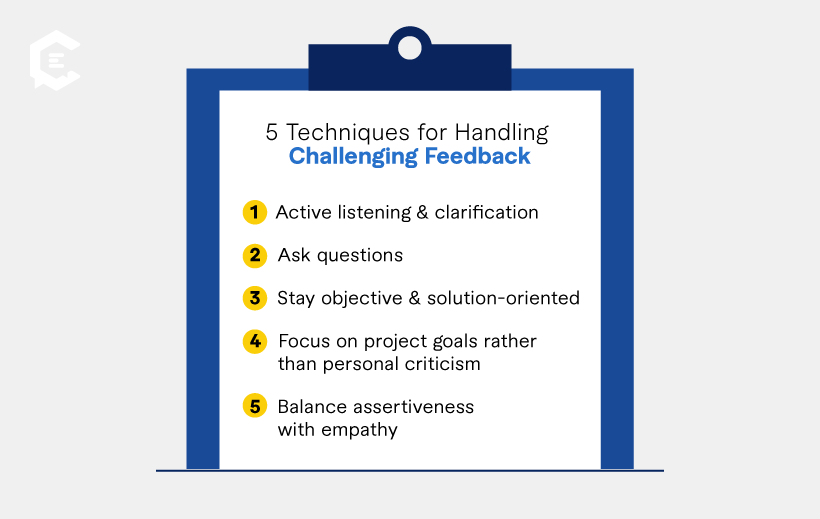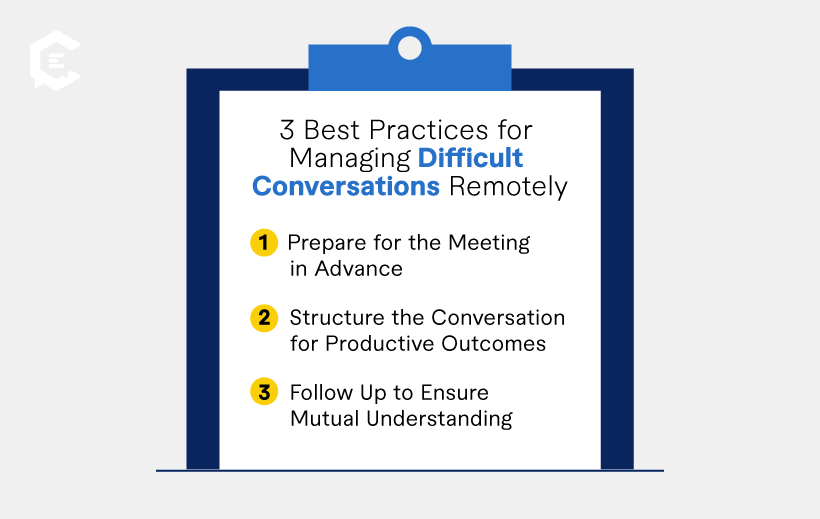Tough conversations in content marketing are unavoidable. This is true whether you’re dealing with critical feedback from a client, an underperforming freelancer, or team issues (or all three).
But with the right communication strategy and tools, you can handle these interactions with ease. Learn how to maintain positive relationships, increase project quality, and achieve your goals by improving your communications.
3 Types of Difficult Conversations (and Potential Solutions)
Difficult conversations don’t have to derail projects or affect quality. Here’s how to turn potential conflicts into opportunities for growth and collaboration.

1. Conversations With Clients
Difficult client conversations often revolve around feedback. It might be a creative disagreement, a change in project direction, or a mismatch between expectations and deliverables. It could also be a panicked client due to bad press or a failed launch.
Here’s how you can keep client conversations proactive:
Set Clear Expectations Early On
A major factor in avoiding tough client conversations is nailing down expectations early. Define deliverables, timelines, and review processes in detail.
For example, clarify how many rounds of revisions are included in the scope of work. When clients know what to expect, they’re less likely to spring surprises on you mid-project.
Respond to Negative Feedback Constructively
When feedback arrives, especially negative, approach it with curiosity rather than defensiveness. Ask follow-up questions that allow you to understand the core concern.
If a client feels the content isn’t hitting the mark, keep the conversation constructive. Instead of getting defensive, ask them to clarify specific concerns.
A client who provides constructive feedback is a green flag that tends to mean they want to work with you for the long haul. So, collaborate with them and be open to what they have to say.
Understanding the “why” behind the feedback is essential for creating solutions that work for both sides.
If they say, “This content doesn’t align with our brand,” ask what part of the message feels off. Is it the tone, the messaging, or the visuals?
Once you have those specifics, you can adjust accordingly.
2. Conversations With Freelancers
Freelancers are a crucial part of many content marketing teams, but managing them remotely comes with its own challenges.
Manage Revisions and Miscommunications
A common challenge with freelancers is handling revisions. If a freelancer is repeatedly not following your direction or missing key points, document feedback and communicate it through a reliable platform.
For example, consider using a shared document in Google Docs or a feedback system like Frame.io to consolidate comments and minimize back-and-forth confusion.
At ClearVoice, our platform allows clients to tag writers directly, streamlining collaboration and reducing miscommunications. This feature facilitates clear dialogue between clients and freelancers, allowing both sides to ask questions and get clarification as needed.
Maintain Professionalism Despite Differing Perspectives
Freelancers may have a different perspective on the creative process. This can sometimes lead to tension, particularly if revisions aren’t up to standard.
When managing freelancer relationships:
- Focus on the project: Keep discussions centered on work-related matters, not personal differences.
- Align with client needs: Ensure all feedback and revisions are geared towards meeting the client’s objectives.
- Stick to the facts: Reference specific instances such as missed deadlines or misaligned revisions.
- Maintain professionalism: Base your communication on concrete examples rather than subjective opinions.
3. Conversations With Team Members
No one enjoys bringing up missed deadlines or underperformance, but direct communication is vital to keeping your team aligned on expectations.
Address Underperformance or Missed Deadlines
When someone on your team isn’t meeting expectations, address it promptly but tactfully. Reference specific instances where they fell short and frame the discussion around finding a solution.
For instance, you could say, “We noticed this project was submitted late. How can we adjust timelines or workloads to avoid this happening again?”
This creates space for improvement without making team members feel attacked.
Use Remote-Friendly Conflict Resolution for Distributed Teams
With remote teams, conflict resolution can be more complex. Tone isn’t easy to distinguish in written communications, which can lead to misunderstandings.
Sometimes, a phone or video call is more productive than an email thread or Slack message to help clarify your points — and ensure your tone is received correctly.
5 Techniques for Handling Challenging Feedback
Now that we’ve identified the main types of tough talks, let’s explore some tried-and-true techniques for handling challenging feedback like a pro.
1. Active Listening and Clarification
One of the most effective ways to manage feedback is through active listening. This involves paying attention to the words being said and the emotions and intentions behind them.
Clients, freelancers, and team members all want to feel heard.
Echoing their concerns back to them with a simple, “Here’s what I’m hearing — does that sound right?” can help clarify and defuse tension.
2. Ask Questions
Instead of assuming what the other person means, ask clarifying questions.
If a client says, “This doesn’t work for me,” get to the root of the issue by asking them what feels off. This shifts the conversation from a vague critique to a specific and actionable discussion.
3. Stay Objective and Solution-Oriented
In challenging conversations, emotions can easily take over, but staying focused on the project is crucial. Aim to keep the discussion grounded in solutions rather than dwelling on problems.
If a client is dissatisfied, propose concrete next steps. For example, you could acknowledge where your team missed the mark and propose adjusting the messaging to better reflect the client’s brand voice.
4. Focus on Project Goals Rather Than Personal Criticism
Direct the conversation back to the shared goal: creating successful content. When you frame the discussion around achieving the best outcome rather than placing blame, it becomes easier to move forward constructively.
5. Balance Assertiveness with Empathy
Being assertive doesn’t mean being aggressive. Stand firm on your position while demonstrating empathy for the other person’s point of view.
This balance is critical when dealing with clients who may be upset or freelancers who feel their creative vision isn’t being valued.
Must-Have Digital Tools and Platforms to Facilitate Communication
Having the right tools can make all the difference in facilitating smooth communication. Let’s explore some must-have platforms for different scenarios.
Tools for Client Communication
When working with clients, having the right communication tools is essential. Tools like Slack, Trello, and Asana help maintain transparency, track progress, and ensure everyone’s on the same page.
For more complex projects, these platforms help prevent miscommunication by keeping feedback centralized and easy to follow.
Tools for Freelancers and Teams
Freelancers and remote teams benefit from clear, documented feedback systems. Google Docs allows for collaborative revisions in real-time, while platforms like Frame.io help consolidate feedback on visual projects.
Keeping conversations organized and easily accessible helps prevent any misunderstanding that might arise from scattered communications.
When to Use Which Tool
It’s important to know when to use different tools for different scenarios.
- Asynchronous tools (email, project management software): Use for detailed, non-urgent feedback that requires thorough processing and documentation.
- Instant messaging (Slack, Google Chat): Employ for quick, urgent communications with team members and freelancers, like troubleshooting, instant updates, and quick clarifications.
- Video conferencing (Zoom, Microsoft Teams): Use for longer, in-depth conversations to address significant issues where tone and intent are crucial. Video calls are also helpful for screen sharing.
- Phone calls: Opt for immediate, direct communication on time-sensitive issues that require quick resolution but don’t necessitate video.
At ClearVoice, we use Slack to communicate with our internal team and freelancers. If a writer hasn’t accepted an assignment or urgent edits are needed, we can quickly alert those involved — and resolve the issue.
3 Best Practices for Managing Difficult Conversations Remotely
What you say — and how you say it — becomes even more important when having conversations remotely.
1. Prepare for the Meeting in Advance
When addressing a sensitive issue in a remote setting, always come prepared. Review the problem, gather relevant data, and anticipate possible reactions. This ensures that the conversation is structured and remains productive.
2. Structure the Conversation for Productive Outcomes
Start the conversation by outlining the issue, then propose a way forward.
For example, “We’ve encountered some challenges with timelines. I’d like to discuss how we can adjust the process to meet our deadlines more consistently.”
Framing the conversation around solutions gives it a positive tone.
3. Follow Up to Ensure Mutual Understanding
After a difficult conversation, always follow up with a written summary of what was discussed and agreed upon.
Whether it’s an email or a task update in a project management tool, having a record helps everyone stay on track and avoids future miscommunication.
Turn Conflict Into Collaboration
With the right preparation, active listening, and clear communication tools, you can turn difficult interactions into opportunities for stronger collaboration, whether with clients, teams, or freelancers.
Focus on the work and maintain empathy, and you’ll be able to navigate even the toughest conversations with ease.
Connect with a ClearVoice content strategist today to discover how our communication-centric approach can transform your content marketing efforts, reduce misunderstandings, and deliver









